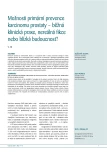SCREENING OF PROSTATE CANCER
Authors:
A. Kazzazi; B. Djavan
Authors‘ workplace:
Department of Urology, New York University School of Medicine (NYU), New York University Hospital
Published in:
Urol List 2011; 9(2): 13-17
Overview
The advent of prostate-specific antigen (PSA) testing in the early 1980s revolutionized the diagnosis of prostate cancer. As a result of PSA testing, there has been a surge in the number of prostate cancer diagnoses. This review examines the results of 2 recent landmark trials that studied the effect of screening on prostate cancer mortality: the European Randomized Study of Screening for Prostate Cancer (ERSPC) and the US-based Prostate, Lung, Colorectal, and Ovarian (PLCO) Cancer Screening Trial.
Key words:
PSA screening, European Randomized Study of Screening for Prostate Cancer (ERSPC), Prostate, Lung, Colorectal, and Ovarian (PLCO) Cancer Screening Trial
Sources
1. Eyre, H, Kahn, R, Robertson, RM et al. Preventing cancer, cardiovascular disease, and diabetes. A common agenda for the American Cancer Society, the American Diabetes Association, and the American Heart Association. American Cancer Society, 2004 Jun.
2. Andriole GL, Crawford ED, Grubb RL et al. Mortality results from a randomized prostate-cancer screening trial. N Engl J Med 2009: 360; 1310–1319.
3. Schröder FH, Hugosson J, Roobol MJ et al. Screening and prostate-cancer mortality in a randomized European study. N Engl J Med 2009: 360(13): 1320–1328.
4. Stephenson RA. Prostate cancer trends in the era of prostate specific antigen: an update of incidence, mortality, and clinical factors from the SEER database. Urol Clin North Am 2002; 29(1): 173–178.
5. SEER Prostate – Cancer Statistics Review, Available at: http://seer.cancer.gov/csr/1975_2006/results_merged/sect_23_prostate.pdf, Accessed on 7.29.09.
6. Catalona WJ. Treatment strategies for prostate cancer. JAMA 1993; 270(14): 1691–1692.
7. Sun L, Gancarczyk K, Paquette EL et al. Introduction to Department of Defense Center for Prostate Disease Research Multicenter National Prostate Cancer Database, and analysis of changes in the PSA era. Urol Oncol 2001; 6: 203–209.
8. Roehl KA, Han M, Ramos CG et al. Cancer progression and survival rates following anatomical radical retropubic prostatectomy in 3,478 consecutive patients: long-term results. J Urol 2004; 172(3): 910–914.
9. Schwartz KL, Grignon DJ, Sakr WA et al. Pro-state cancer histologic trends in the Metropolitan Detroit area, 1982 to 1996. Urology 1999; 53(4): 769–774.
10. Carter HB, Epstein JI, Partin AW. Influence of age and prostate specific antigen on the chance of curable prostate cancer among men with non-palpable disease. Urology 1999; 53(1): 126–130.
11. Smith RA, von Eschenbach AC, Wender R et al. ACS Prostate Cancer Advisory Committee, ACS Colorectal Cancer Advisory Committee, ACS Endometrial Cancer Advisory Committee. American Cancer Society guidelines for early detection of cancer: update of early detection guidelines for prostate, colorectal and endometrial cancers. Also: update 2001-testing for early lung cancer detection. CA Cancer J Clin 2001; 51(1): 38–75.
12. Hankey BF, Feuer EJ, Clegg LX et al. Cancer surveillance series: interpreting trends in prostate cancer-part I: Evidence of the effects of screening in recent prostate cancer incidence, mortality, and survival rates. J Natl Cancer Inst 1999; 91(12): 1017–1021.
13. Draisma G, Boer R, Otto SJ et al. Lead times and overdetection due to prostate-specific antigen screening: estimates from the European Randomized Study of Screening for Prostate Cancer. J Natl Cancer Inst 2003; 95(12): 868–878.
14. Humphrey PA, Keetch DW, Smith DS et al. Prospective characterization of pathological features of prostatic carcinomas detected via serum prostate specific antigen based screening. J Urol 1996; 155(3): 816–820.
15. Paeratakul S, Popkin BM, Keyou G et al. Changes in diet and physical activity affect the body mass index of Chinese adults. Int Obes Relat Metab Disord 1998; 22(5): 424–431.
16. Albertson PC, Fryback DG, Storer BE et al. Long term survival among men with conservatively treated localized prostate cancer. JAMA 1995; 274(8): 626–631.
17. Canfield S. Commentary; Annual Screening for prostate cancer did not reduce mortality from prostate cancer. Evid Based Med 2009; 14(4): 104–105.
18. Catalona WJ, Smith DS, Ornstein DK. Prostate cancer detection in men with serum PSA concentrations of 2.6 ng/ml to 4.0ng/ml and benign prostate examination. Enhancement of specificity with free PSA measurements. JAMA 1997; 277(18): 1452–1455.
19. Horninger W, Cheli CD, Babaian RJ, et al. Complexed prostate specific antigen for early detection of prostate cancer in men with serum prostate specific antigen levels of 2 to 4 nanograms per millilitre. Urology 2002; 60 (4 Suppl 1): 31–35.
20. Oesterling JE, Jacobsen SJ, Chute CG et al. Serum prostate specific antigen in a community-based population of healthy men: established age-specific reference ranges. JAMA 1993; 270: 860–864.
21. Morgan TO, Jacobsen SJ, McCathy WF et al. Age-specific reference ranges for prostate specific antigen in black men. N Engl J Med 1996; 335(5): 304–310.
22. Bartsch G, Horninger W, Klocker H et al. Prostate cancer mortality after introduction of prostate specific antigen mass screening in the federal state of Tyrol, Austria. Urology 2001; 58(3): 417–424.
23. Labrie F, Candas B, Dupont A et al. Screening decreases prostate cancer death: first analysis of the 1988 Quebec prospective randomized controlled trial. Prostate 1999; 38(2): 83–91.
24. Kobuke M, Saika T, Nakanishi Y. Prospective Longitunial Comparative Study of Health-Related Quality of Life in Patients with Radical Prostatectomy or Permanent BRachytherapy for Prostate Cancer. Acta Med Okayama 2009; 63(3): 129–135.
Labels
Paediatric urologist UrologyArticle was published in
Urological Journal

2011 Issue 2
Most read in this issue
- A SUMMARY OF NEW TECHNOLOGIES FOR PROSTATE CANCER (ROBOT, LAP, BRACHY, CRYO, CYBERKNIFE)
- EAU GUIDELINES ON PROSTATE CANCER - PART 1: SCREENING, DIAGNOSIS, AND TREATMENT OF CLINICALLY LOCALISED DISEASE
- SCREENING OF PROSTATE CANCER
- EAU GUIDELINES ON PROSTATE CANCERPART 2: TREATMENT OF ADVANCED, RELAPSING, AND CASTRATION-RESISTANT PROSTATE CANCER
